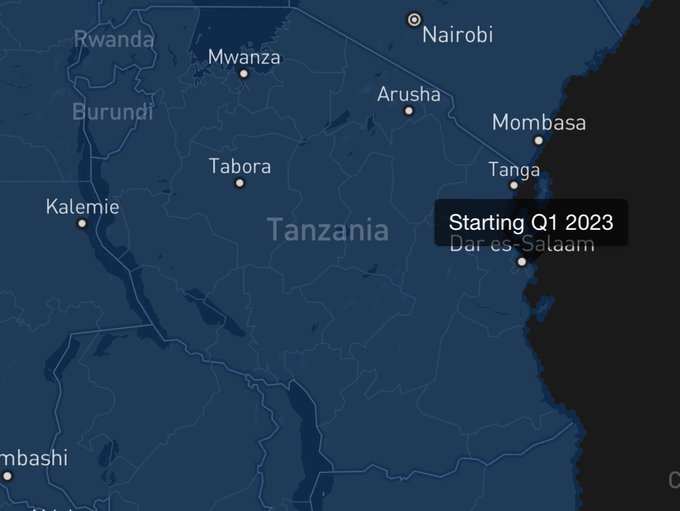Elon Musk’s Starlink stated their goal to offer the services between January and March, ‘subject to regulatory permission’
According to The Citizen Tanzania, the service, which is owned by the SpaceX Company, has been providing internet connectivity using thousands of satellites in space that communicate with designated transmitters on the ground.
Those who spoke to The Citizen say that the new service will only stimulate the digital sector if it is sold at a cheap price and provides high-speed internet.
On their official website, Starlink announced their plan to bring the services between January and March subject to regulatory approval. It remains to be announced what regulatory approval the Tanzania Government will impose.
However, the Director General of the Tanzania Communications Authority (TCRA), Jabiri Bakari confirmed to The Citizen that the Starlink Company sent an application.
When asked if he was aware of the arrival of Starlink Corporation, Dr Bakari replied: “Yes, I am aware that the company applied through the website.
The only African countries that have so far allowed Starlink to operate are Nigeria and Mozambique.
This was done after obtaining regulatory approvals from both nations.
Whether Starlink will have a big impact or not will depend on how the business expects to provide services quickly and cheaply, according to economist Abel Kinyondo from the University of Dar es Salaam.
“Internet service is not a luxury but a basic need. Its high speed and affordability can mean high speed and quick access to information,” he said.
On their official website, Starlink announced their plan to bring the services by between January and March depending on regulatory approval.
Tanzania Communication Regulatory Authority (TCRA) director general Jabiri Bakari confirmed to The Citizen that the Starlink Company had made an application.
When asked if he was aware of the Starlink Corporation’s impending arrival, Dr Bakari replied: “Yes, I am aware that the company had made an application through a portal.
The only African nations that have so far let Starlink to operate are Nigeria and Mozambique. This was done after obtaining regulatory permits from both nations.
Whether or not the Starlink will have a significant impact will depend on how quickly and affordably the business expects to deliver its service, according to economist Abel Kinyondo from the University of Dar es Salaam.
“Internet service is no longer a luxury, but something which it is a basic need. Its high speed and affordability could mean high speed and fast access to information,” he recounted.
Again, it will help traders do their online businesses and also get training meant to make them do it better.
“This service will set a stage for the growth of the digital economy in the country,” he exuded his optimism. His sentiments were echoed by an innovator and technology enthusiast Mr Jumanne Mtambalike on the grounds that the Starlink internet service will stimulate the digital economy.
Mr Mtambalike, who doubles as the Sahara Ventures CEO, said the service will shape various sectors ranging from agriculture, education to health. “I am optimistic the Starlink internet service will create an enabling environment for e-learning, e-health and research,” expounded Mr Mtambalike.
“Starlink’s internet service will spur innovation and so is competition among the private companies.
“The service will offer significant impact, especially in remote areas where the infrastructure is too poor to accommodate fiber cables.” Those people, he explained, will get the fastest internet because the speed is almost 150mbps, and that is much cheaper compared to other satellite services.
“So what Elon Musk is trying to do is to make it affordable and this commendable indeed,” appreciated Mr Mtambalike.
With the service, both users will share the same infrastructure in space with $99 installation kits which are available to deposit through its website.
On the other hand, Mr Mtambalike said depending on the license they will be given by TCRA, it will set a ground for stiff competition with local services providers.
For users to access Starlink internet service, they need to mount a dish on a clear sky and have the Wi-Fi router, cables and base.
Internet access in many African countries is very slow to the point that even people who can afford it still face some limitations when using it.

Share this news
This Year’s Most Read News Stories

Fast Satellite Internet in Kenya by June
Elon Musk’s satellite Internet firm Starlink announced it will launch in Kenya in the second quarter of this year.Continue Reading

Tanzania: Samia Hands Over NBC’s 354m/ – Crop Insurance Compensation to Farmers Affected By Hailstorms
President Samia Suluhu Hassan, has handed over a cheque of 354m/- from the National Bank of Commerce (NBC) as compensation to tobacco farmers, who were affected by hailstorms during the previous farming season in various regions across the country.
Handing over the cheque in Dodoma, the compensation is part of the crop insurance service provided by NBC in collaboration with the National Insurance Corporation (NIC).
Furthermore, President Samia has also handed over health insurance coverage to members of the Lindi Mwambao Cooperative Union based in Lindi Region, through the Farmers’ Health Insurance service provided by the bank in partnership with Assurance Insurance Company.
While visiting the bank’s pavilion at the Nanenane Agricultural Exhibition and being received and briefed by the bank’s Managing Director, Mr. Theobald Sabi, she said: “This crop insurance is one of the crucial solutions in ensuring farmers have a reliable income, without fear of challenges such as natural disasters, including hailstorms.
“I call upon all farmers in the country to make the best use of this important opportunity by accessing these kinds of insurance services. I also highly commend NBC and all the stakeholders participating in this programme.”
Elaborating further on the crop insurance service, the Minister of Agriculture, Hussein Bashe, stated that it will help to recover the loss farmers incurred, especially in various calamities beyond their control.
Citing them as floods, fires, and hailstorms, which have significantly affected the well-being of farmers and caused some to be reluctant to invest in the crucial sector, Mr Bashe added: “However, our President, this step by NBC is just the beginning, as this is the second year since they started offering this service, and the results are already visible.

Sign up for free AllAfrica Newsletters
Get the latest in African news delivered straight to your inbox
“As the government, we promise to continue supporting the wider implementation of this service, with the goal of ensuring that this crop insurance service reaches more farmers.”
ALSO READ: NBC participates in TFF 2023/24 awards, promises to enhance competition
On his part, Mr Sabi said that the farmers who benefited from the compensations are from 23 primary cooperative unions in the regions of Shinyanga, Geita, Tabora, Mbeya, Katavi, and Kigoma.
He added: “In addition to these insurance services, as a bank, through this exhibition, we have continued with our programme of providing financial education and various banking opportunities to farmers, alongside offering them various loans, including loans for agricultural equipment, particularly tractors, to eligible farmers.:
At the NBC booth, President Samia also had the opportunity to be briefed on the various services offered by the bank to the farmers namely crop insurance and health insurance services.
There, the President had the chance to speak with some of the beneficiaries of the services, including the Vice-Chairman of the Lindi Mwambao Primary Cooperative Union, Mr. Hassan Mnumbe, whose union has been provided with a health insurance card from the bank.
Source: allafrica.com

Ankaya Village: Experience active living and wise investment in Zanzibar
Ankaya Village offers more than just a place to live—it’s a lifestyle choice that’s as enriching as it is rewardingContinue Reading












